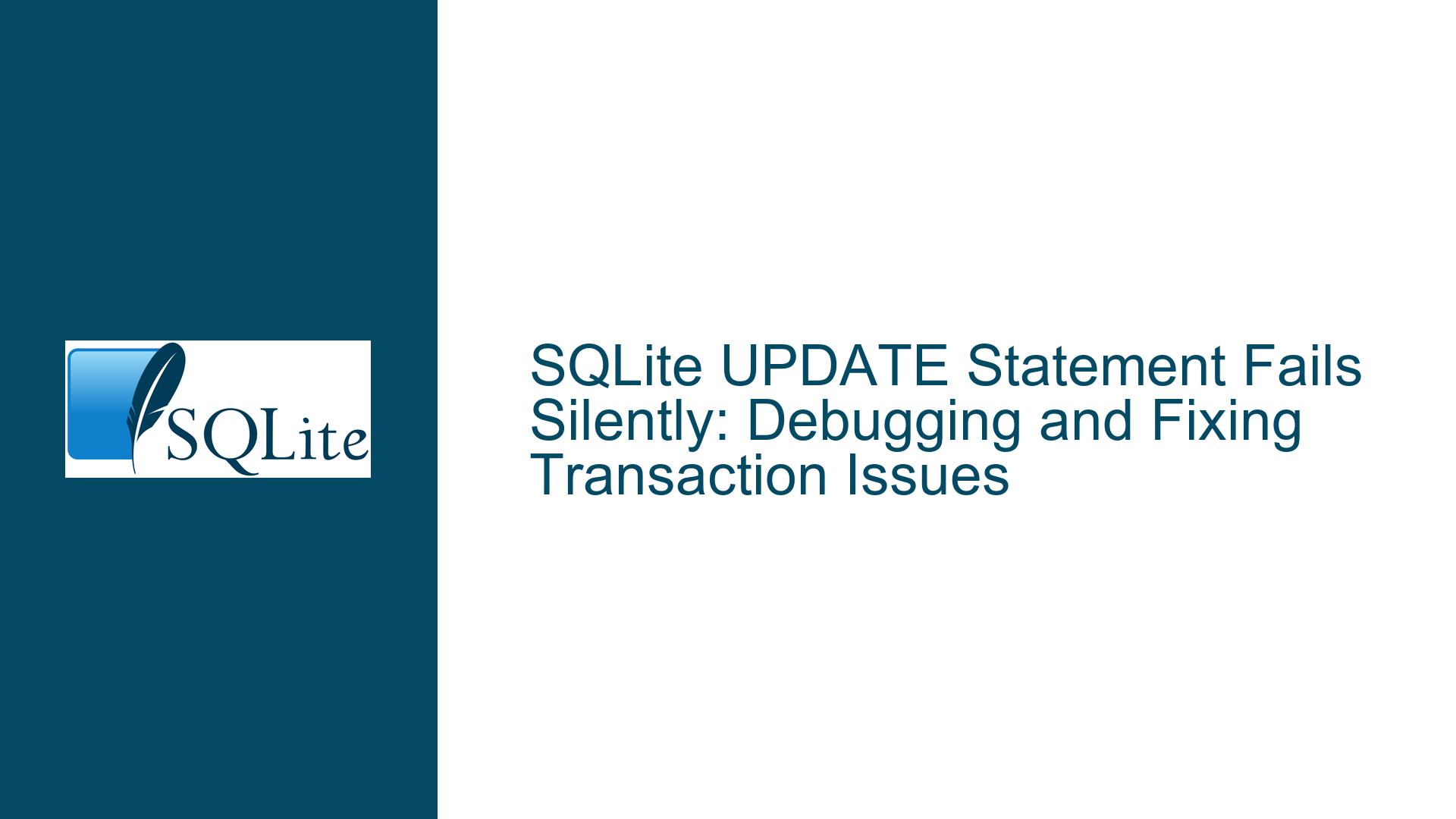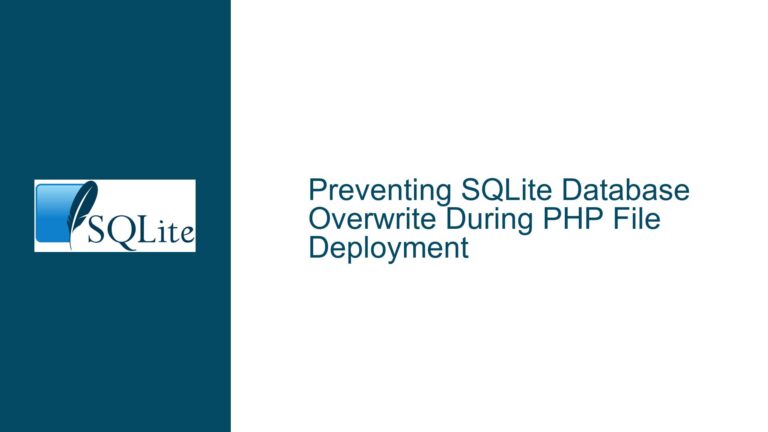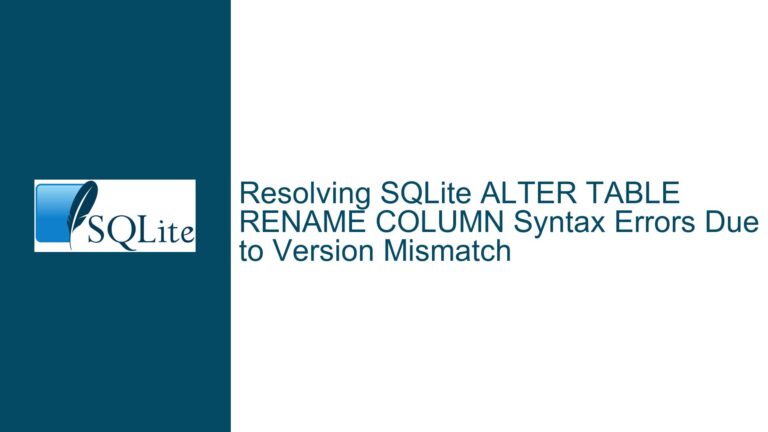SQLite UPDATE Statement Fails Silently: Debugging and Fixing Transaction Issues
Issue Overview: Silent Failure of UPDATE Statements in SQLite C API
The core issue revolves around an UPDATE statement that fails silently when executed via the SQLite C API, while the same statement runs successfully when manually executed in an SQLite console. The user reports that INSERT statements work as expected, but UPDATE statements do not produce any visible changes or errors. This discrepancy suggests that the problem lies not in the SQL syntax or the database schema but in the surrounding code or transaction management.
The user’s code snippet reveals that the UPDATE statement is constructed and executed correctly, as confirmed by the sqlite3_expanded_sql() function, which emits a valid SQL statement. However, the UPDATE operation does not persist or produce any visible changes in the database. This behavior is particularly puzzling because the same statement works flawlessly when executed manually in an SQLite console.
The issue is further complicated by the fact that the user is working with a multi-function codebase where database operations are spread across several functions. This setup increases the likelihood of transaction management issues, such as uncommitted changes or overlapping transactions, which can lead to silent failures.
Possible Causes: Transaction Management and Database State
The silent failure of the UPDATE statement can be attributed to several potential causes, all of which are related to transaction management or the state of the database at the time of execution. Below are the most likely culprits:
1. Uncommitted Transactions
One of the most common reasons for silent UPDATE failures is the presence of uncommitted transactions. If the UPDATE statement is executed within a transaction that is never committed, the changes will not be persisted to the database. This can happen if the transaction is explicitly started using BEGIN TRANSACTION but not followed by a COMMIT statement. Alternatively, the transaction might be rolled back due to an error or an explicit ROLLBACK statement.
In the user’s case, the issue was traced back to a misplaced early return in another function. This early return occurred after a BEGIN TRANSACTION statement but before the corresponding COMMIT. As a result, the transaction was left open, and the UPDATE statement was never committed.
2. Incorrect Database Connection
Another potential cause is the use of an incorrect or stale database connection. If the g_canvas.backing_db variable does not point to the correct database connection, the UPDATE statement will be executed on the wrong database, leading to no visible changes. This can happen if the database connection is closed and reopened without updating the reference in g_canvas.backing_db.
3. Transaction Isolation Levels
SQLite’s default transaction isolation level is SERIALIZABLE, which ensures that transactions are executed in a way that mimics serial execution. However, if the user’s code involves multiple concurrent transactions, it is possible that the UPDATE statement is being executed in a transaction that cannot see the changes made by other transactions. This can happen if the transactions are not properly synchronized or if the isolation level is set to a stricter mode.
4. Trigger or Constraint Interference
While not explicitly mentioned in the discussion, it is worth considering whether triggers or constraints might be interfering with the UPDATE statement. For example, a trigger might be defined to roll back the transaction if certain conditions are met, or a constraint might prevent the UPDATE from being applied. However, this is less likely in this case, as the same statement works when executed manually.
5. Race Conditions
If the user’s code involves multiple threads or processes accessing the same database, race conditions could lead to silent UPDATE failures. For example, if one thread starts a transaction and another thread attempts to update the same row, the second thread might fail silently if the first thread holds a lock on the row.
Troubleshooting Steps, Solutions & Fixes: Resolving Silent UPDATE Failures
To diagnose and resolve the issue, follow these detailed troubleshooting steps:
1. Verify Transaction Commit
The first step is to ensure that the transaction containing the UPDATE statement is properly committed. Add a COMMIT statement immediately after the UPDATE statement and check if the changes are persisted. If the changes are now visible, the issue was likely due to an uncommitted transaction.
In the user’s case, the problem was resolved by moving the early return in the database initialization function to before the BEGIN TRANSACTION statement. This ensured that the transaction was properly committed.
2. Check Database Connection
Verify that the g_canvas.backing_db variable points to the correct database connection. This can be done by logging the database file path or using the sqlite3_db_filename() function to retrieve the filename associated with the connection. If the connection is incorrect, update the reference to point to the correct database.
3. Test with Explicit Transaction Management
To rule out transaction isolation issues, test the UPDATE statement with explicit transaction management. Start a transaction using BEGIN IMMEDIATE or BEGIN EXCLUSIVE to ensure that no other transactions can interfere. Commit the transaction immediately after the UPDATE statement and check if the changes are persisted.
4. Inspect Triggers and Constraints
Review the database schema for any triggers or constraints that might interfere with the UPDATE statement. Use the sqlite3_master table to list all triggers and constraints associated with the tiles table. If any are found, test the UPDATE statement with the triggers or constraints temporarily disabled.
5. Check for Race Conditions
If the code involves multiple threads or processes, ensure that proper synchronization mechanisms are in place. Use SQLite’s built-in locking mechanisms, such as BEGIN IMMEDIATE or BEGIN EXCLUSIVE, to prevent race conditions. Alternatively, use a mutex or other synchronization primitive to ensure that only one thread or process can access the database at a time.
6. Enable SQLite Debugging
Enable SQLite’s debugging features to gain more insight into the transaction behavior. Use the sqlite3_trace() function to log all SQL statements executed by the database connection. This can help identify any unexpected behavior, such as uncommitted transactions or incorrect isolation levels.
7. Test with a Minimal Example
Create a minimal example that reproduces the issue. This should include only the necessary code to execute the UPDATE statement and verify the changes. By isolating the issue, you can rule out any external factors and focus on the core problem.
8. Review the Commit
Finally, review the commit that fixed the issue to understand the root cause. In this case, the issue was caused by a misplaced early return in the database initialization function. By moving the early return to before the BEGIN TRANSACTION statement, the transaction was properly committed, and the UPDATE statement worked as expected.
By following these troubleshooting steps, you can identify and resolve the root cause of silent UPDATE failures in SQLite. The key takeaway is to carefully manage transactions and ensure that all changes are properly committed. Additionally, always verify that the correct database connection is being used and that no external factors, such as triggers or race conditions, are interfering with the UPDATE statement.






